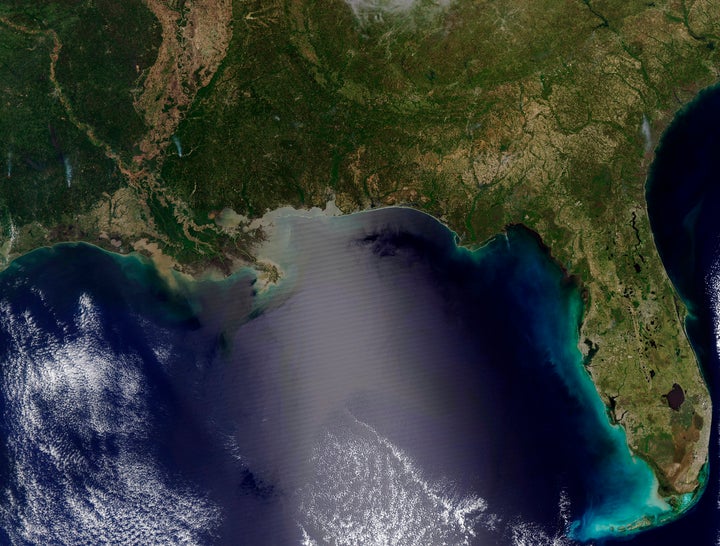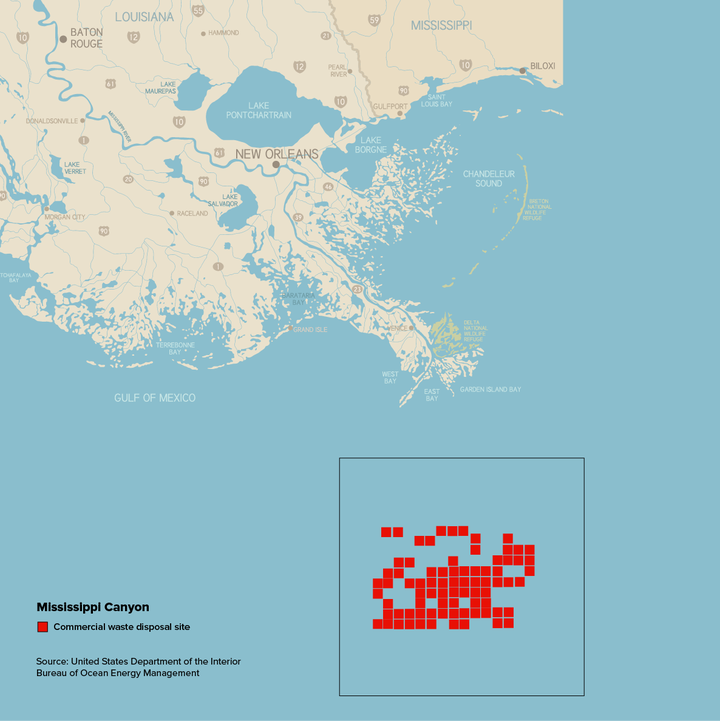
After a HuffPost investigation last year brought to light a vast, decades-old chemical dumping ground in the Gulf of Mexico, the Environmental Protection Agency has officially declared that the site is nothing to worry about ― without reviewing any recent scientific data or visiting the site.
Last year, HuffPost reported that tens of thousands of 55-gallon drums containing decades-old toxic waste are scattered across a 200-square-mile stretch of ocean floor off the coast of Louisiana, in an area known as Mississippi Canyon. Fossil fuel companies now operate a network of drilling rigs and pipelines within the barrel field — a development that has the potential to disturb drums on the seafloor. The EPA acknowledged at the time it has done little to no oversight since permitting chemical companies to jettison waste there in the 1970s, nor does it know if this offshore dumping has had lingering environmental or human health impacts.
In response to HuffPost’s reporting, the EPA launched a review to determine whether the site qualifies for study or cleanup under the federal Superfund program. The assessment is called a pre-CERCLA screening, under the Comprehensive Environmental Response, Compensation, and Liability Act, better known as Superfund.
The EPA’s review concluded that the site “is not eligible for further investigation” under Superfund because there is no evidence of harm.
“No release has been indicated and no threat to human health and the environment has been shown,” Michelle Delgado-Brown, a Superfund site assessment manager at EPA Region 6 in Dallas, wrote in her decision. “Due to the distance from the shoreline (approximately 60 miles offshore) and the depth of the disposal (3,000-feet depth of water), there is no direct contact threat for public health and there are currently no known environmental/public health concerns associated with the site.”
The report is dated Dec. 29, 2021, but was not provided to HuffPost until last week.

For the screening, Delgado-Brown solely reviewed EPA-issued dumping permits and other historical documents from the 1970s. Every reference document in the report is from 1977 or prior. The agency did not collect or review sediment or water samples for the presence of pollutants, consult with independent scientists or oil and gas companies that operate in the area, or consider how offshore development might be impacting existing barrels, according to information in the report.
The result is a document that shines little if any new light on a forgotten, nearly 50-year-old dumping ground — and shuts the door on a more thorough study.
“EPA did not perform any kind of comprehensive evaluation,” Charles McCreery, a former water quality expert with the federal Bureau of Ocean Energy Management who spent years investigating and trying to bring attention to the site, said via email when contacted about the findings. “They looked at permits and not the site.”
McCreery, who issued a report on the site to Congress in 2019, stressed that he’s aware of no publicly available surveys or sediment analyses of the barrel field.
Samantha Joye, an oceanographer and microbiologist at the University of Georgia who has done extensive research in Mississippi Canyon, called the EPA’s screening perfunctory and inadequate.
“This is classic ‘out of sight, out of mind,’” she said.
The EPA did not respond to HuffPost’s request for comment on the report.
To be fair, pre-CERCLA screenings are skeleton reviews meant to guide the EPA in determining next steps for sites brought to the agency’s attention. On its website, the EPA describes them as “relatively low-cost initial” assessments that involve “reviewing existing information and collecting minimal additional information to determine whether a site warrants entry into the Superfund active inventory for further site assessment evaluation.”
Only about one-fifth of these screenings lead to further action under Superfund, including in-depth assessments, site visits and remediation.
But the EPA’s decision to forgo a more comprehensive assessment at Mississippi Canyon — the kind that could dive into the concerns scientists raised last year about potential impacts to the environment, fisheries and even human health — appears to hinge on the agency’s own dearth of knowledge about the site.
The EPA is responsible for monitoring designated offshore dumping grounds. Yet it has not tracked potential short- and long-term environmental impacts at the inactive Mississippi Canyon dump site. As an agency spokesperson told HuffPost last year, “Potential effects have not been assessed.”

In some cases, the EPA required chemical companies to study environmental impacts, including whether contaminants persisted in the food chain, as a condition of their offshore dumping permit. In 1973, for example, DuPont reported to the EPA that its barrel dumping in Mississippi Canyon resulted in “no long-term or short-term effects” and that it did not find “any definitive pattern that bioaccumulation has been greater inside the dumping zone than outside.”
The EPA keeps this and other impact reports in its archives, but did not review them as part of its eight-month screening. HuffPost has only reviewed the DuPont study, which McCreery obtained as part of a public records request.
There’s also nothing in the EPA’s report to indicate that the probe included consulting with the Bureau of Ocean Energy Management or the Bureau of Safety and Environmental Enforcement, which regulate offshore oil and gas development and require companies to report any incidents involving barrels at Mississippi Canyon.
As of last year, there had been no reported incidents of worker exposure or equipment damage in the barrel field, according to the BOEM.
The two Interior Department bureaus routinely notify offshore operators of the hazards associated with the site, where an estimated 205,000 steel barrels of chlorinated hydrocarbons and other chemical wastes were discarded.
“Bidders and lessees are advised that the blocks associated with the disposal site and adjacent blocks that are included in the sale area may exhibit hazards from barrel contents (toxic, corrosive, and/or potentially explosive materials),” read a notice for last year’s Gulf lease sale.
EPA’s pre-CERCLA decision form includes a 12-question checklist about the site and its known associated risks. In response to the question about whether there is “evidence of an actual release or a potential to release” at the Mississippi Canyon barrel field, Delgado-Brown answered “no.”
But saltwater is known to corrode steel over time, and an internal policy that Shell maintains for avoiding seafloor drums while operating in Mississippi Canyon notes that “many of the barrels may have released their contents over time.”
“The metallurgy of these drums at some point is going to fail,” said Chris Reddy, an environmental chemist and marine pollution expert at Woods Hole Oceanographic Institution in Massachusetts.
Reddy is part of a team that studied a site off the coast of Los Angeles where as many as half a million barrels of the potent and highly toxic insecticide DDT were dumped. Underwater robots captured pictures of barrels that were corroded, punctured and leaking chemicals onto the seafloor. Others looked crunched and weakened, Reddy said.
Reddy acknowledged that an in-depth investigation of the Mississippi Canyon site would likely prove costly and labor-intensive, but said he expected more from the EPA’s initial assessment given the potential for the dumped waste to have included more hazardous compounds and byproducts than what companies listed in their 1970s discharge permits.
“Our capacity to detect and measure pollutants has dramatically increased in the last 50 years,” he said. “There’s certainly science that could be added to this conversation.”
Read the EPA’s report below:
